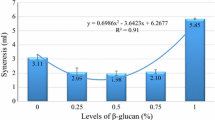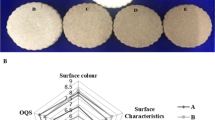Abstract
The quality of salep depends on its chemical composition, especially its glucomannan content, which varies according to the species. Saleps from 20 different orchid species collected from various regions in Turkey were analyzed for dry matter, ash, protein, glucomannan and starch contents. Moreover, viscosity and solubility of these saleps (1% w/v) in water and milk with different sucrose levels (15–25% w/v) were investigated. Starch and glucomannan contents of the species were found between 4.58–43.98 and 7.84–48.54%, respectively. Saleps obtained from Dactylorhizaromana ssp. georgica, Orchis tridentata and Serapiasvomeracea ssp. vomeracea species were identified as the species that contained the highest glucomannan content (42–48%) which could provide the highest viscosity in water and milk solutions. Additionally, despite having relatively lower glucomannan and starch content (36 and 35%), the water solution made with salep from Himantoglossum affine exhibited high viscosity and suggested that a synergistic effect existed between starch and glucomannan. Saleps from nine orchid species contained more than 40% glucomannan but only three of them exhibited good thickening properties and can provide ideal viscosity in water and milk with the addition of sucrose (658–690 cP).
Similar content being viewed by others
References
E. Sezik, Orkidelerimiz (Sandoz Kültür Yayınları, İstanbul, 1984), pp. 1–120
N. Bozkurt, in Anadolu Orkideleri, ed. by F. By, Akbaş (Say Yayınları, İstanbul, 2012)
C.A.J. Kreutz, Türkiye Orkideleri (RotaYayınları, İstanbul, 2009)
C.E. Tamer, B. Karaman, O.U. Çopur, Food Rev. Int. 22, 43–50 (2006)
E. Sezik, Türkiye’nin Salepgilleri, Ticari Salep Çeşitleri ve Özellikle Muğla Salebi Üzerine Araştırmalar (İstanbul Üniversitesi Eczacılık Fakültesi, İstanbul, 1967), pp. 45–130
F. Javidi, S.M.A. Razavi, F. Bwhrouzian, A. Alghooneh, Food Hydrocoll. 52, 625–633 (2016)
O.C. Tekinşen, K.K. Tekinşen, Dondurma: Temel Bilgiler, Teknoloji, Kalite Kontrolü (Selçuk Üniversitesi Basımevi, Konya, 2008), pp. 34–67
E. Sezik, Acta Pharmaceutica Turcica. 44, 151–157 (2002)
Megazyme International Ireland Limited, Glucomannan Assay Procedure K-GLUM 10/04 (Wicklow, Ireland, 2004)
Megazyme International Ireland Limited, Total Starch Assay Procedure (amyloglucosidase / α-amylase Method) AA/AMG 11/01, AOAC Method 996.11.Wicklow., Ireland (2004b)
A&D Company Limited, SV-10 Vibro Viscometer Instruction Manual, Japan (2005)
L.S. Sciarini, F. Maldonado, P.D. Ribotta, G.T. Pérez, A.E. León, Food Hydrocoll. 23, 306–313 (2009)
D. Betancur-Ancona, J. Lopez-Luna, L. Chel-Guerrero, Food Chem. 82, 217–225 (2003)
E. Sezik, B. Özer, Kastamonu Salebinin Menşei ve Kastamonu Civarının Orkideleri (TÜBİTAK, Ankara, 1983), pp. 35–245
K.K. Tekinşen, A. Güner, Food Chem. 121, 468–471 (2010)
R. Farhoosh, A. Riazi, Food Hydrocoll. 21, 660–666 (2007)
G. Dragendorf, Pharm. Zeitschr. f. Russland. 4, 165 (1965)
M. Sulak, İ Aydın, OMÜ Ziraat Fakültesi Dergisi. 20, 106–109 (2005)
K.K. Tekinşen, A. Güner, Kahramanmaraş Yöresinde Yetişen Saleplerin Kimyasal Bileşiminin ve Bazı Fizikokimyasal Niteliklerinin Araştırılması (Selçuk Üniversitesi Bilimsel Araştırma Projeleri, Konya, 2009), pp. 1–114
A. Koyun, Endüstriyel Dondurma Üretiminde Yağsız Süt Tozu Yerine Peyniraltı Suyu Protein Konsantresi Kullanımının Dondurmaya Uygunluğunun Araştırılması (Namık Kemal Üniversitesi Fen Bilimleri Enstitüsü, Tekirdağ, 2009), pp. 25–92
S. Adapa, K.A. Schnidt, I.J. Jeon, T.J. Herald, R.A. Flores, Food Rev. Int. 16, 259–271 (2000)
Author information
Authors and Affiliations
Corresponding author
Rights and permissions
About this article
Cite this article
Şen, M.A., Palabiyik, I. & Kurultay, Ş. Composition, viscosity and solubility of saleps from twenty different orchid (Orchidaceae) species. Food Measure 12, 1334–1339 (2018). https://doi.org/10.1007/s11694-018-9747-y
Received:
Accepted:
Published:
Issue Date:
DOI: https://doi.org/10.1007/s11694-018-9747-y




